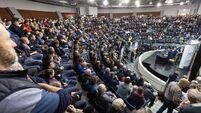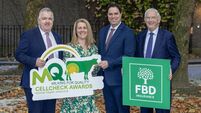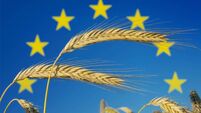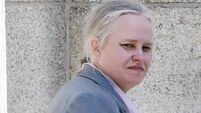Paula Hynes: The day our daughter took a calf to school

Rathard Choco Kalani with Aisling and Georgie at Kilbonane National School.
Before the schools closed for their mid-term break, Kalani took a trip to school with Georgie. The principal of Kilbonane National School, Mr Brophy, has always been great at encouraging students with their talents and hobbies — and for Georgie, showing ticks both boxes.
Kalani’s dam, Kasey, had visited the school with Georgie in 2022, so it was a lovely reminder of how time flies when we saw Kalani in the schoolyard with Georgie. The duo put on a display of what happens in a showmanship class and explained what a judge looks for in a dairy animal.
Once Georgie had shared her passion for dairy showing with her classmates, everyone had the chance to say 'hi' to Kalani.
Assisted by her best friend Aisling, Georgie then spent time introducing Kalani to all the classes in the school. As a typical Jersey show calf, she thrived on the attention and happily posed for photos with the youngsters.
We often forget that even though we farm in rural communities, many of our neighbouring children have never been up close with a calf. Some kids brim with confidence and will walk up and rub it straight away, while for others, it’s a daunting moment to get so close to a farm animal — but once they do, it becomes a lasting memory.
The cost of producing a litre of milk is now 42c, yet only a few years ago farmers could produce that same litre for 26 or 27c. While milk prices are higher than they were then, the reality is that most farmers are losing money due to current price cuts.
Beef, too, has become expensive for consumers, yet the average income for a suckler farmer is estimated at just €20,000. The cost of running a business in Ireland has become far too high, and fuel prices, along with carbon taxes, are driving those costs further.
A carbon tax might be designed to save the planet, but in reality, it’s putting people out of business.
Fastway Couriers are a prime example — they were haemorrhaging money because the cost of delivering a parcel had become so high, yet the price they were paid didn’t cover the expense.
Fuel and energy costs are crippling farmers, particularly the costs of running machinery and keeping milk parlours operating.
The only way we’ll ever bridge this gap with consumers is by sharing knowledge and making an effort to connect with our non-farming neighbours. There’s also a golden opportunity for our dairy and beef breed societies to play a role in this — using agricultural shows to build closer links with schools, especially at national level.
Showing teaches responsibility, develops valuable skills, and opens doors to travel and work abroad. Yet, the agricultural industry continues to struggle to attract young people — so we need creative ways to bring them in.
The equine industry has a schools show jumping competition — imagine if our national dairy or livestock shows hosted a schools showing competition, where each school could enter a team for dairy or beef showmanship: two students from a farming background and two non-farming teammates.
The farming kids would share their skills and learn teamwork, while the non-farming kids would get a real taste of life in our industry.
The weather took a turn for Halloween, and ground conditions have deteriorated. We dried off 40 cows to coincide with trick-or-treating, looking at milk yields and calving dates to select the group.
Any low-yielders made the list straight away — there’s no point milking a cow that won’t pay her way at current milk prices. With calving due to kick off at the start of January, some cows also needed their holiday break.
Kasey, Kali and Acclaim are now officially on milking holidays too.
All cows received a long-acting dry cow tube and Fatroseal teat sealers. While selective dry cow therapy is an option, we believe the dry period is the best time to use antibiotics to ensure cows calve down with a low SCC.
It’s surely better to use antibiotics at that stage than to be firefighting mastitis mid-lactation. The dry cows were housed straight away and fed dry haylage for a few days, with plenty of attention paid to liming cubicles.
Just as some of the cows are going on holidays, so too are we preparing to fly south for a warmer climate and a well-earned recharge.
Getting ready for holidays, farmer-style, is a little more tedious than just packing a suitcase — making lists of what could go wrong while we’re away and double-checking that every part of the farm is running smoothly. We tackle the big jobs before we go, think ahead to what will need doing when we return, and often end up doing those too before leaving.
We’ll have a great team in place while we’re away — Becky thrives on managing the place, and Katherine will be here to help her. When you’re a farmer, you really need a holiday by the time you’ve finished getting ready to go on one.











